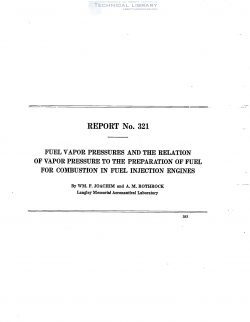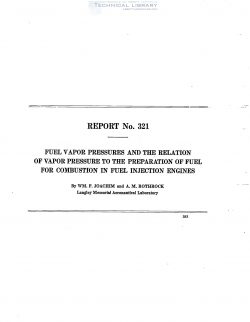naca-report-321

- Version
- 260 Downloads
- 895.75 KB File Size
- 1 File Count
- August 25, 2016 Create Date
- August 25, 2016 Last Updated
National Advisory Committee for Aeronautics, Report - Fuel Vapor Pressures and the Relation of Vapor Pressure to the Preparation of Fuel for Combustion in Fuel Injection Engines

This investigation on the vapor pressures of fuels was conducted at the Langley Memorial
Aeronautical Laboratory at Langley Field, Va., in connection with the general research on combus-
tion in fuel injection engines. The purpose of the investigation was to study the ejects of high
temperatures such as anist during the first stages of injection on the vapor pressures of seceral fuels
and certain fuel mixtures, and the relation of these vapor pressures to the preparation of the fuel for
combustion in high-speed fuel injection engines.
The apparattrs employed in the tests consisted of a gas-tight steel bomb, a Bourdon spring
pressure gauge, an electric furnace, a thermocouple, and a potentiometer. The bomb was par-
tially filled with the fuel to be tested, the space above the fuel filled with nitrogen to prevent
combustion, and the bomb heated in an electric furnace. Pressure and temperature readings
were taken simultaneously during the heating and cooling periods over a temperature range
from 175° to approximately 900° F. Vapor and gas pressures up to 5,000 pounds per
square inch were measured. The fuels tested were gasoline, kerosene, Diesel engine fuel oil,
ethyl alcohol, methyl acohol, benzol, mixtures of methyl alcohol and gasoline, and mixtures of
benzol and gasoline. An aircraft engine lubricating oil was also tested. Water was tested as
a standard in order to compare these results with those of other investigators. The conditions,
of the tests were similar to those met in the combustion chamber of a. fuel injection engine and
consequently the data apply to those conditions.
It was found that the vapor pressures of the fuels increased rapidly at high temperatures,
the rate of pressure increase becoming greater as the temperatures approached the critical
value. Beyond the critical temperature, the‘ rate of pressure increase was constant except at
one or more temperatures in the case of certain fuels and their vapors in which chemical changes
took place. The chemical changes in some of the fuels were such that the cooling curves were
materially different from those obtained during the heating periods. Permanent gases were
generated during the heating and cooling periods in the case of the alcohols, gasoline, kerosene,
and Diesel engine fuel oil so that the fuels removed from the bomb were materially difierent
from those placed in it. The vapor pressures of the fuels difiered from each other considerably,
methyl alcohol having the highest vapor pressure, 4,370 pounds per square inch, and Diesel
engine fuel oil the lowest, 14.0 pounds per square inch, for the maximum temperature investi—
gated, approximately 850° F.
| File | Action |
|---|---|
| naca-report-321 Fuel Vapor Pressures and the Relation of Vapor Pressure to the Preparation of Fuel for Combustion in Fuel Injection Engines.pdf | Download |

Comment On This Post